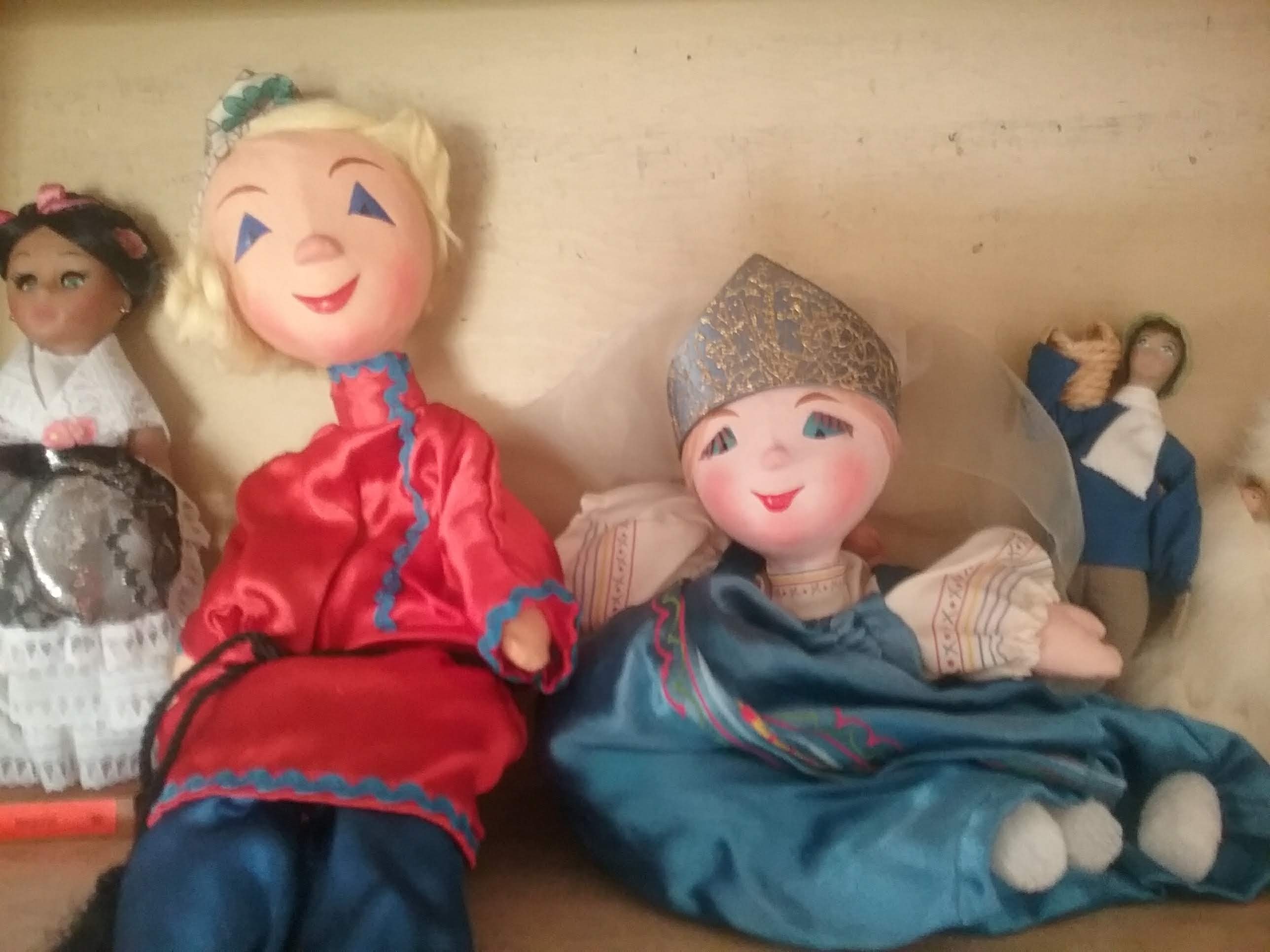

Some of the storytelling dolls that Pam Miller has collected in the Storytelling Resource Place
Pam Miller, founder and president of the Storytelling Resource Place, Jonesborough, Tennessee, is fascinated with stories: collecting them, telling them and writing about them. She is particularly interested in fairy tales, especially “Cinderella.”
“Once upon a time,” my grandfather would read to me, and I was totally enchanted. These fairy tales made perfect sense to me. The world that I lived in was full of magic: blossoms pushed out of the dead ground, rainbows spanned the sky, and every chicken provided a wish bone. Sometimes as I grew up, the line between fairy tale and my life became blurred. In Indiana I, too, was a princess awaiting discovery,” Miller says.
After she graduated from college, she sold all her belongings and moved to California to attend graduate school. “No fairy tale heroine ever met more colorful characters than I did in Los Angeles in the 1970s.”
Her first teaching job took her to New Mexico, “The Land of Enchantment,” where she taught communication education on Native American pueblos.
“I learned about storytellers and stories which formed the texture of their culture. After several years, I went to another magical land famous for a castle, Hearst Castle. I taught at Cal Poly, San Luis Obispo, California, for 12 years: performance of literature, storytelling, and readers theater. The more I taught about storytelling, the more my passion grew to become a teller and share the wonderful stories, no longer commonly known, with new generations. Fairy tales still made the most sense to me. They provided a world view consistent with my own. Many events could not be explained except through magic.
“I’ve always been a reader and collected books about fairy and folk tales, myths, legends, epics and classic works of children’s literature which drew upon these traditional oral traditional sources such as King Arthur, The Narnia books by C.S. Lewis, “The Lord of the Rings,” Harry Potter series. I’m a professional scholar and gather books as a way to have permanent objects to remind me of ideas,” she says.
For decades Miller has been drawn to the Cinderella story and its many different versions. This motivated her to write “Cinderella: or The Heroine with a Thousand Shoes.” Her primary reasons are that most people have the mistaken belief that “Cinderella” was created by Walt Disney in 1950; that “Cinderella” was a children’s story which was irrelevant for adults and that the lead character was passive and helpless.
“Instead, we find that ‘Cinderella’ is one of the most popular and well-known stories of all time. Hundreds and even thousands of versions exist some even aboutyoung men who lose their boot and wed a princess. It is one of the oldest stories that we have: either beginning in ancient Egypt with Cinderella and her Prince buried together in a pyramid or from early Chinese dynasties which provided the detail of the heroine’s tiny foot, called the “lotus foot.” The six plot motifs have been used again and again in culture after culture with delightful results. Beginning with oral storytellers, the story of the persecuted heroine recurs from country to country in songs and works of art. Not only versions of the tale but also this set ofplot motifs or circumstances have been studied by psychologists, theologians, literary critics, educators, just to mention a few,” Miller says.
Another project that is close to her heart is the Storytelling Resource Place, a collection of stories and storytelling materials in Jonesborough, Tennessee.
Since the activity of storytelling preceded the printed word, they collect not only books but also puppets, dolls, musical instruments, costumes, and drums, foxtails, posters and other artifacts. They also collect recordings of spoken stories available by digital recording, CDs or DVDs.
“We have a cooperative and supportive relationship with the International Storytelling Center. Their Director Kiran Singh Sirah was our first member in 2016. The I.S.C. has recommended to individuals that they could donate their books and magazine collections to us. We also are working with the tellers that are coming into town this summer by interviewing them for the new Storytellers’ Legacy Project. Our collection is available for use by all the storytelling organizations and story listeners.
“We have a healthy number of Appalachian and southern oral stories and traditions, but we also have another large section for the other areas in the world and throughout the world,” Miller says.
She is also a storyteller. After she became a mother, she began to tell stories in parks, churches, schools and at birthday parties. She is a member of the Jonesborough Storytellers Guild and has been for 10 years.
“The heart of this collection is the amazing phenomenon of storytelling. This activity has been how we create meaning and memories, connect with one another, identify common values and understand the sacred. Yes, stories are definitely for entertainment but also inspire us and the stories that we believe and revere are those which involve our values and our hope for the future. In some special way, the stories that we share unite us and define us.
“This essential human activity is the center of my collection so that we never forget to preserve our stories and our respect for the stories of others,” Miller says.
For more information about the Storytelling Resource Place, visit www. https://storytellingresourceplace.com. Copies of her book are available by personal order at fairytaleteller246@gmail.com.